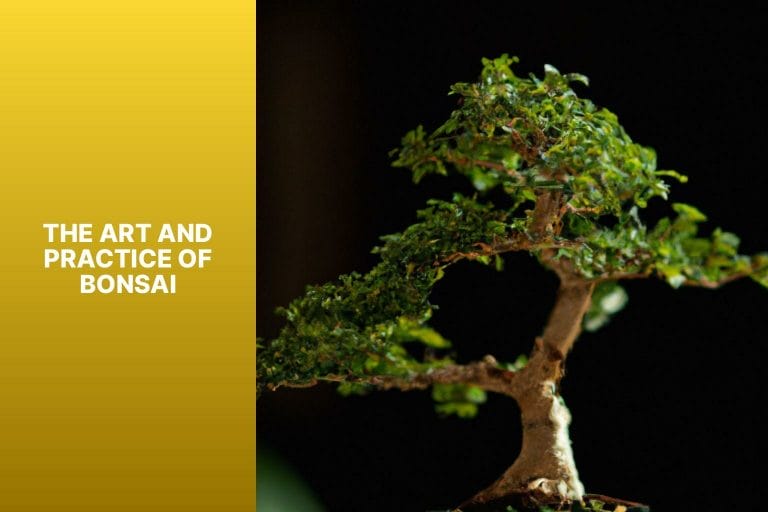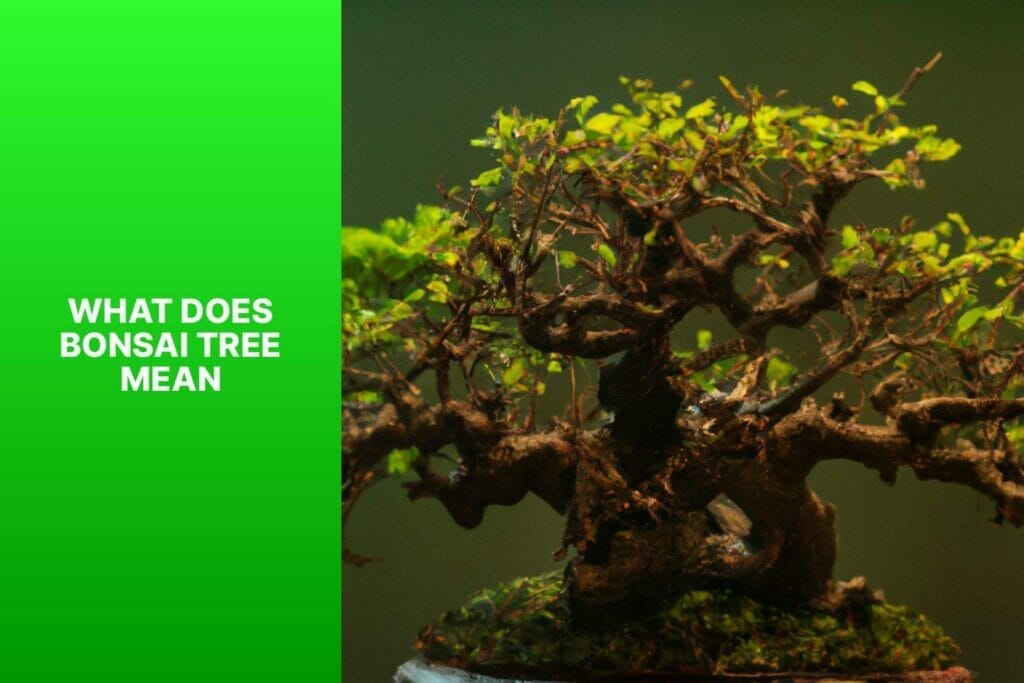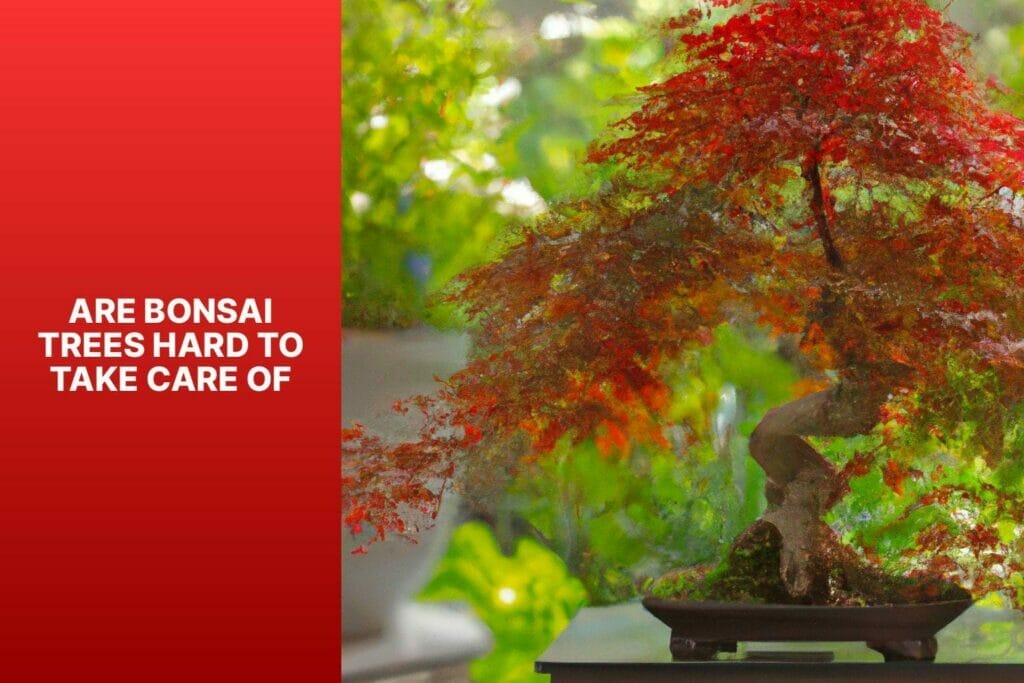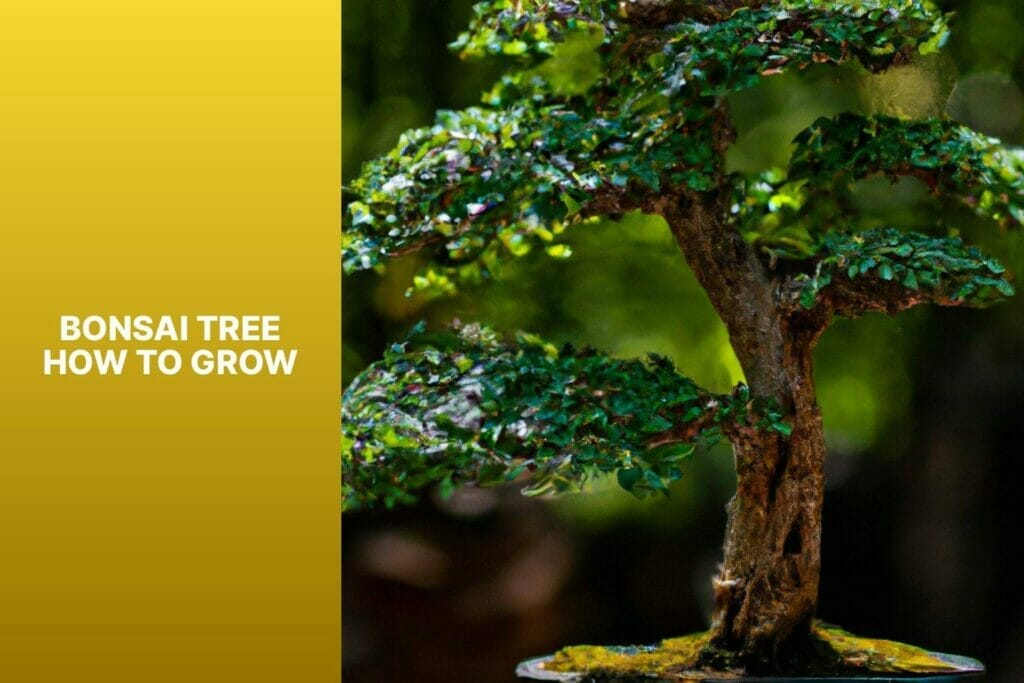Bonsai trees have long fascinated people with their miniature size and artistic beauty. But what exactly does the term “bonsai” mean? Explore these captivating trees’ meaning, origins, and symbolic significance.
Bonsai is a Japanese term that translates to “tray planting” in English. It refers to the art of growing trees in containers, replicating the shape and proportion of full-sized trees but on a much smaller scale.
Bonsai trees are meticulously cultivated to create a harmonious balance between the tree, the pot, and the surrounding environment.
The origins of bonsai trees can be traced back to ancient Chinese horticultural practices, later adopted and refined by the Japanese.
The art of bonsai first emerged in Japan around the 6th century and has since become deeply rooted in Japanese culture, philosophy, and aesthetics.
Symbolically, bonsai trees hold profound meanings. They are often associated with patience, resilience, and the appreciation of natural beauty. Bonsai trees are regarded as living works of art that reflect the harmony between nature and human intervention.
In Japanese culture, they represent Zen Buddhism principles, evoking a sense of peace, tranquility, and enlightenment.
The art and practice of bonsai require careful cultivation and maintenance. Bonsai trees are shaped and trained using pruning, wiring, and root pruning techniques.
These techniques passed down through generations, allow bonsai enthusiasts to create unique and captivating tree designs.
There are numerous bonsai trees, each with its characteristics and styles. Popular species used for bonsai include the Japanese maple, pine, juniper, and azalea.
Each bonsai style, such as formal upright, informal upright, and cascade, has distinct characteristics in terms of trunk shape, branch placement, and overall aesthetic.
Key takeaway:
- Bonsai trees maximize beauty: Bonsai trees are miniature versions of full-sized trees, allowing for the appreciation of nature’s beauty on a smaller scale. They can bring a sense of tranquility and harmony to any space.
- Bonsai trees symbolize deep meanings: These trees are rich in symbolism and can represent concepts such as strength, resilience, and the cycle of life. They hold cultural significance in various traditions and are often considered a living art form.
- The art of bonsai requires careful cultivation: Bonsai trees require specific techniques and care to achieve their desired form and size. Pruning, wiring, and careful soil and water monitoring are essential for their growth and health.
What Is a Bonsai Tree?
A bonsai tree, also known as a miniature tree, is a small tree that resembles a mature tree. This unique art form originated in China but has become strongly associated with Japanese culture.
Bonsai trees are typically grown in small pots and carefully pruned to maintain their small size and enhance their natural beauty.
They require special care, such as regular watering, proper fertilization, and strategic placement to keep these trees healthy and promote growth. Bonsai trees symbolize harmony, balance, and patience and are highly regarded as an art form by enthusiasts and collectors worldwide.
If you want to care for a bonsai tree, it is important to remember that they are living organisms and need regular maintenance to thrive.
Therefore, investing in proper tools, learning species-specific care instructions, and becoming part of a bonsai community can greatly contribute to your bonsai tree’s long-term health and beauty.
What Are the Origins of Bonsai Trees?
Bonsai trees have their origins in ancient China and Japan. Culturing miniature trees in containers began in China over a thousand years ago.
It was later adopted and developed by the Japanese, eventually becoming a unique art form. “bonsai” originates from Japan and translates to “tray planting.”
The initial creation of bonsai trees in China had religious and spiritual purposes, symbolizing the harmony between humans, nature, and the divine—the Chinese bonsai style aimed to create the illusion of a full-sized tree in a miniature form.
When bonsai was introduced to Japan during the Kamakura period, it gained popularity among the aristocracy and samurai.
Japanese bonsai artists embraced the concept of capturing the essence of nature and adapting it to fit human-sized spaces. They developed distinct styles such as formal upright, informal upright, and cascade.
The origins of bonsai trees showcase the influence of both Chinese and Japanese cultures on this unique art form. The Chinese introduced the concept of cultivating miniature trees, while the Japanese refined it into an art that deeply connects with nature.
Today, bonsai trees are treasured and cultivated worldwide for their beauty and symbolic significance.
What Does the Term “Bonsai” Mean?
“Bonsai” refers to a Japanese art form of growing miniature trees in containers. Here are some key aspects of what “Bonsai” means:
- Miniature trees:
Bonsai trees are meticulously shaped and trained to resemble full-sized trees in nature. They are pruned and wired to maintain their small size.
- Cultivation:
“Bonsai” signifies the process of growing and maintaining these miniaturized trees. It combines horticulture, artistry, and patience.
- Art form:
Bonsai is a living art form that requires creativity, skill, and aesthetic sensibility. The trees are carefully shaped to achieve balance, harmony, and a natural look.
- Container gardening:
Bonsai trees are grown in small containers or pots, enhancing the aesthetic appeal. The containers are chosen thoughtfully to complement the tree’s design.
- Precision and attention to detail:
Bonsai involves meticulous care, including pruning, wiring, watering, and repotting. “Bonsai” represents the dedication and precision required to create and maintain these small trees.
- Symbolism:
Bonsai is often associated with tranquility, balance, and harmony. In Japanese culture, it embodies the spirit of nature and the essence of life.
Symbolic Meaning of Bonsai Trees
Bonsai trees possess a profound symbolic meaning in numerous cultures. They symbolize harmony, balance, and a connection to the natural world. The patient and disciplined cultivation of these miniature trees reflects the values and respect for nature that bonsai enthusiasts hold dear.
Symbolically, bonsai trees represent a variety of concepts. They embody the beauty and resilience of nature, demonstrating how something small and delicate can flourish with careful nurturing.
Bonsai trees symbolize tranquility and inner peace, reminding us to embrace the present moment and slow down. They can represent the cycle of life and the enduring spirit of growth.
An anecdote vividly illustrates the symbolic meaning of bonsai trees. On their wedding day, a young couple received a bonsai tree representing their journey together.
Throughout the years, they diligently cared for the bonsai, pruning and shaping it as they faced the challenges and joys of married life. As the tree grew stronger, so did their relationship.
Today, the well-maintained bonsai stands tall and vibrant, serving as a testament to their unwavering love and commitment.
The symbolic meaning of bonsai trees transcends their physical beauty. They remind us of our connection to nature, the value of patience and discipline, and the significance of nurturing relationships.
Understanding the symbolic meaning of bonsai trees enables us to truly appreciate the art form and the profound messages it conveys.
What Do Bonsai Trees Symbolize?
Bonsai trees symbolize harmony, balance, and perseverance. These miniature trees are cultivated to represent natural landscapes in a confined space.
The art of bonsai involves shaping and pruning the tree to create a harmonious composition that captures the essence of nature.
Bonsai trees symbolize harmony by embodying the balance between man and nature. They remind us of the beauty and tranquility found in the natural world.
Maintaining a bonsai tree requires meticulous care, reflecting perseverance and dedication.
In Japanese culture, bonsai trees reflect the values and aesthetics of the country. They represent simplicity, patience, and respect for nature.
Bonsai is not just a decorative art form but a way of connecting with the natural world and finding inner peace.
The symbolic meaning of bonsai trees can vary based on the style and species of the tree. For example, a cascading style bonsai symbolizes serenity and tranquility, while an upright style bonsai represents strength and stability.
What Is the Cultural Significance of Bonsai Trees?
Bonsai trees hold deep cultural significance in Japanese culture. They represent the cultural significance of bonsai trees in Japanese culture through their embodiment of harmony, balance, and patience.
Bonsai trees reflect the principles of Zen Buddhism and the Japanese mindset of finding beauty in simplicity.
In addition to this, bonsai trees also promote tranquility, contemplation, and mindfulness. They are considered a form of living art that requires nurturing and dedication, aligning with the Japanese values of discipline and perseverance.
Bonsai trees are commonly displayed in homes and gardens in Japanese culture, symbolizing longevity, good fortune, and a connection to nature. They bring nature indoors and contribute to the creation of a peaceful environment.
The care and attention bonsai enthusiasts give to trimming, shaping, and nurturing their trees further enhance the cultural significance of these miniature masterpieces.
Fact: Bonsai trees have been cultivated in Japan for centuries and are considered part of the country’s cultural heritage. Their timeless beauty and symbolic significance inspire artists, gardeners, and nature lovers worldwide.
The Art and Practice of Bonsai

Photo Credits: Mnbonsainetwork.Com by Alexander Scott
The Art and Practice of Bonsai involve various key elements and techniques contributing to creating and maintaining miniature trees.
Selection is crucial, as choosing the right tree species, such as pine, juniper, maple, and elm, significantly influences the outcome.
Each species has unique characteristics and growth patterns, which add to the aesthetic appeal of the bonsai.
One of the essential techniques is pruning and shaping. Regular pruning helps maintain the bonsai’s size and shape by removing unwanted branches and leaves, resulting in an aesthetically pleasing form and improved tree balance.
Another technique, wiring, enables the shaping of branches and desired movement. Carefully applying wire is necessary to guide the growth of branches in the intended direction.
Repotting is another vital aspect of bonsai care. Periodically repotting the bonsai provides fresh soil and promotes root growth, ensuring the tree’s health and allowing for root pruning.
Adequate watering and fertilizing are also necessary for bonsai growth and development. Balancing these factors according to the specific tree species is crucial for optimal health.
The display and presentation of bonsai are essential considerations.
Bonsai is not solely about the tree itself but also about how it is showcased. Choosing suitable pots, stands, and display arrangements adds to the artistic presentation and enhances the overall beauty of the bonsai.
By understanding and practicing these techniques, bonsai enthusiasts can cultivate and appreciate the beauty and intricacy of miniature trees.
The art and practice of bonsai require dedication, patience, and a deep appreciation for nature’s artistic expressions.
How Are Bonsai Trees Cultivated?
To cultivate bonsai trees, you must follow these steps on how are bonsai trees cultivated:
1. Select the right tree: Choose a suitable tree species for bonsai cultivation, such as juniper, pine, maple, or ficus.
2. Trim and shape: Regularly prune the branches and roots to maintain the desired size and shape and create the miniature appearance of bonsai trees.
3. Use careful wiring: Shape the branches and trunk of the tree using proper wiring techniques to achieve the desired structure and artistic form of the bonsai.
4. Report regularly: Prevent root-bound growth by repotting the bonsai tree every few years. Prune the roots and replace the soil to maintain the tree’s health.
5. Proper watering and fertilizing: Carefully water the bonsai, ensuring the soil is evenly moist but not soggy. Regularly fertilize with a balanced bonsai fertilizer to provide the necessary nutrients for growth.
6. Positioning and care: Thriving bonsai trees require proper care and attention. Place the tree in suitable sunlight, humidity, and temperature. Please protect it from extreme weather conditions and pests.
Fun Fact: The Tokyo Imperial Palace is home to the oldest known bonsai tree, over 1,000 years old. It has been meticulously cultivated and passed down through generations.
What Techniques Are Involved in Bonsai Tree Care?
Bonsai tree care involves various techniques to ensure the health and beauty of these unique plants. There are several essential steps to follow:
1. Pruning: Regular pruning is necessary to maintain the desired shape and size of the bonsai. This technique removes excess foliage and promotes a balanced and aesthetically pleasing appearance.
2. Wiring: Another technique used in bonsai tree care is wiring. By carefully bending and positioning the branches, bonsai enthusiasts can create characteristic shapes for their trees. Handling the wiring process carefully is important to avoid damaging the branches.
3. Repotting: Repotting is a critical step in bonsai care to provide fresh nutrients and prevent root overcrowding. This technique involves carefully removing the tree from its pot, trimming the roots, and planting it in fresh soil.
4. Watering: Proper watering is vital for bonsai tree health. The frequency and amount of water needed depend on tree species, climate, and season. It is important to ensure the roots remain sufficiently moist without becoming waterlogged.
5. Fertilizing: Regular fertilization is key to maintaining health and promoting the growth of bonsai trees. Specially formulated bonsai fertilizers should be applied based on the specific needs of each tree species.
6. Sunlight: Placing bonsai trees in locations where they receive appropriate sunlight is crucial. Some trees may require partial shade, while others thrive in direct sunlight. Finding the right balance of sunlight is essential for their well-being.
7. Pest and disease control: Regular inspection and prompt action are necessary to prevent and control pests and diseases. Practicing proper hygiene and cleanliness can help minimize the risk of infestations.
Throughout history, bonsai tree care has been a passion for dedicated enthusiasts. Originally developed in China and refined in Japan, bonsai cultivation has become an art form that embodies patience, balance, and harmony with nature.
These miniature trees captivate people worldwide with their beauty and unique appeal.
Different Types of Bonsai Trees
Different Types of Bonsai Trees
There are many types of bonsai trees, each with unique characteristics and requirements. Here are some popular varieties:
– Juniper Bonsai: The Juniper bonsai has a distinctive shape and rugged appearance. It thrives both indoors and outdoors.
– Japanese Maple Bonsai: The Japanese Maple bonsai has delicate leaves and vibrant colors, adding elegance to any space.
– Pine Bonsai: Pine bonsai trees have long needles and an upright growth habit. They need plenty of sunlight.
– Ficus Bonsai: The Ficus bonsai is popular for beginners because it is resilient and low maintenance. It has glossy leaves and can tolerate various growing conditions.
– Chinese Elm Bonsai: The Chinese Elm bonsai tree has small, serrated leaves and a twisting trunk, offering a dramatic and artistic addition to any bonsai collection.
– Serissa Bonsai: Also called the Snowrose bonsai, the Serissa bonsai has delicate white flowers and small leaves, making it a charming and dainty choice for bonsai enthusiasts.
Pro-tip: Consider the climate and environment where you will keep the bonsai tree to ensure its long-term health. Research the specific care guidelines for each type to provide the proper care and conditions needed for thriving.
What Are Some Popular Species Used for Bonsai?
When it comes to bonsai trees, there are popular species used to create these miniature masterpieces.
– Japanese Maple: Known for stunning foliage and delicate branches, the Japanese maple is a favorite choice for bonsai enthusiasts. It is prized for its vibrant colors and unique leaf shapes.
– Juniper: The Juniper tree is a classic choice for bonsai. It has beautiful, textured bark and can be shaped into various styles, including windswept or cascade.
– Pine: Pine trees make excellent bonsai specimens for their resilience and unique needle-like foliage. They are often grown in formal upright or semi-cascade styles.
– Chinese Elm: The Chinese Elm is popular for beginners due to its adaptability and forgiveness. It has small, glossy leaves and can be trained in several bonsai styles.
In addition to these popular species, other varieties like the Ficus, Serissa, and Trident Maple are commonly used for bonsai. Each species has unique characteristics and requirements, allowing bonsai enthusiasts to explore different shapes, sizes, and aesthetics.
Fun Fact: Well-maintained bonsai trees can live for 20 to 100 years, depending on the species and care they receive.
What Are the Characteristics of Each Bonsai Style?
Here are the characteristics of each bonsai style:
– Formal Upright: The trunk grows upright, tapering uniformly from the base to the apex. Branches are shaped symmetrically.
– Informal Upright: The trunk is slightly curved or tilted, giving the tree a natural and relaxed appearance. Branches are arranged asymmetrically.
– Slanting: The trunk slants to one side, creating a dynamic and windswept look. Branches are positioned to complement the slant of the trunk.
– Cascading: The trunk cascades downward, resembling a tree growing down a cliff or over a waterfall. Branches droop and hang below the pot.
– Semi-Cascade: The trunk has a slight tilt or curve, cascading to a lesser degree than the full cascading style. Branches are arranged accordingly.
– Bunjin/ Literati: The trunk is slender and erect, often with twists and bends. Branches are sparse and irregularly spaced, creating a stylized, artistic look.
– Windswept: The trunk and branches are shaped to imitate the effects of strong winds. Branches grow in one direction, leaning and bending with the wind.
Some Well-Known Facts About “What Does Bonsai Tree Mean”:
- ✅ Bonsai trees symbolize calm, harmony, and simplicity.
- ✅ The history of bonsai in China dates back to the Tang Dynasty in the 7th century AD.
- ✅ Bonsai trees represent the harmony, simplicity, and circle of life found in nature.
- ✅ There are different types of bonsai trees, each with its meaning and symbolism.
- ✅ bonsai is a practice that encourages peace, serenity, and patience.


